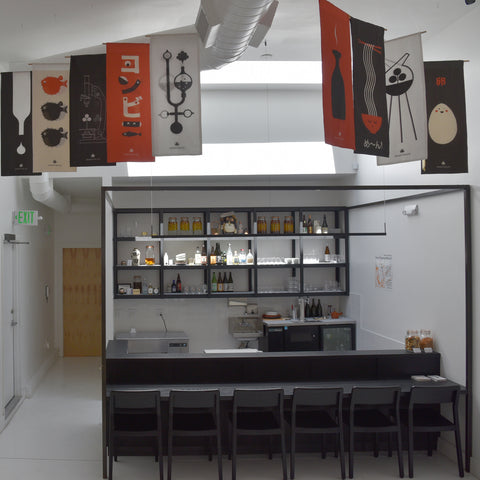
Sake Gumi is our monthly sake subscription service with 150 members throughout California. Join today!
The sakes this month are unlike any sakes you've had before. Some taste like vermouth, others taste like natural wine. If you are the type that likes to explore the fringes and delve into the nichest of the niche - this month is for you. The sakes this month are all brewed using rice from the red rice family (including red and purple rice varietals) that are seldom in production in Japan today - whether for eating or for sake making.
Red rice sakes are rare, but I was able to round up four different sakes for members this month. Within this selection, the range is wide. But the common theme is that all the sakes have a red hue (ranging from light pink to dark red) and have pronounced juiciness, complemented by an acidity, akin to wine.
The emergence of sake brewed from red rice can be traced back to the 1990s. A professor at the Tokyo University of Agriculture who was studying red rice, named Masahisa Takeda, noticed that everyone was making sake that tasted more or less the same. He proclaimed that for sake to survive and move forward, sakes that disrupted mainstream expectations needed to be brewed. In 1996 the Ministry of Agriculture, Forestry, and Fisheries, alongside the university, made a call to sake brewers across Japan to make sake with ancient red rice strains. Several stepped up to the challenge.

Asamurasaki, shown here, is a type of red rice used to make Sakura Emaki and Asamuraki junmai sakes
I asked brewers from this month's selections why they decided to brew a red rice sake. All of the brewers echoed the sentiment of this professor. Kiuchi Brewery, who also makes Hitachino Red Rice Ale with the same rice type wanted to make a sake that stood out from the rest – the result is their Asamurasaki Junmai. Kameman Shuzo was inspired by Professor Takeda and used a native red rice in Kagoshima to make their vermouth-like Hisui that they recommend with sparkling water on ice.
Most sakes are best enjoyed right after bottling. But like some kimotos and yamahais that tend to taste better with some aging, we noticed that these full bodied, high acid sakes improved with time, which allows the flavors to mellow out a bit. For example, you will notice the Hisui was bottled in 2016.
Please join us this month for our monthly Sake Gumi tasting for members only! This is our free monthly event that includes a tasting of the sakes at both levels, plus an extra special something.
Kanpai,
Yoko
LEVEL 1: Introductory Membership (Two 300ml bottles)
 Dewatsuru Sakura Emaki
Dewatsuru Sakura Emaki
Akita Seishu (Akita, Japan)
Seimaibuai: Asamurasaki 60% + Okunomurasaki 60%, SMV: -24
When the fort Hotta No Saku (five minutes from Akita Brewery and active until 1185AD), was excavated, the 1000 year old ancient purple rice, Okunomurasaki, was found. Sakura Emaki is brewed from both Asamurasaki and Okunomurasaki rice. The result is a light, low ABV sake that has the aroma of cherry blossoms, honeysuckles, and peach. A crisp acidity is balanced with a light sweetness. Enjoy this sake chilled alongside summer peppers like shishito or a tomatillo salsa.
 Hisui Red
Hisui Red
Kameman Brewery (Kumamoto, Japan)
Seimaibuai: Hinohikari 75% + Kaoshima Akamai 75%, SMV: -30
Talk about a sake that pushes the limit! This is Kayoko’s favorite bottle this month. As an Italophile (she used to live in Italy) and resident cocktail expert, she likes how this sake reminds her of a typical Italian vermouth. It’s got hints of grape vine, prune, a little funk, and full of polyphenols! We took the brewer’s recommendation to heart and loved this 4-years-aged sake on ice. Enjoy with a meat and cheeseboard. Buon cibo, buon vino, buoni amici, kanpai!
LEVEL 2: Premium Membership (Two 720ml bottles)
 Asamurasaki Junmai
Asamurasaki Junmai
Kiuchi Brewery (Ibaraki, Japan)
Seimaibuai: Gohyakuman-oku 55% + Asamurasaki 100%, SMV: -3
This is my favorite bottle this month because it is so unusual for a sake. The aroma starts with black tea and fermented grapes. Fruity and tart like a saison, funky like a natural rose wine, with an herbal finish (think Ricola), Kiuchi Brewery surely achieved its goal to make a sake that stands out from the rest. A note from the brewer, “Asamurasaki is high in acidity. To balance the taste, we preserved the sweetness of the rice by using the whole rain (no milling) hence a lower SMV.” Drink chilled with foods that have bite like radishes or celery pickles.
 Ginno Kurenai Junmai
Ginno Kurenai Junmai
Amabuki Brewery (Saga, Japan)
Seimaibuai: Saa no Hana 100%, SMV: +1
Drier than the other sakes this month, it has the familiar rice taste that you’d expect from sake. Still, this is a red rice sake and you’ll notice a hint of berry-like sweetness, most likely from the full-bodied rice and strawberry yeast. We loved this alongside our meal at Tacos Oscar, and reminded us a little bit of sangria. Enjoy this one chilled and pair with spicy tacos or chips and salsa.




Comments (1)
Is red rice of the type used when Japanese rice growers make crop-art in their fields? Huge pictures that need to be seen from the air or at least somewhere high up.
They use rice that grows different colours to make huge pictures, the size of the whole field, and very vivid in colour.
So there is rice that grows pale yellow, green, and purple at least, that I’ve seen in photographs. Perhaps next time you’re in Japan you could visit a couple? They organise competitions so it ought not be difficult to find them.